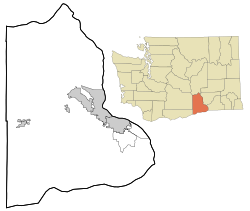White Bluffs, Washington | |
|---|---|
 Remains of the Hudson's Bay Company post at White Bluffs, ca. 1937 | |
| Coordinates: 46°39′59″N 119°29′05″W / 46.6665256°N 119.4847477°W[1] | |
| Country | United States |
| State | Washington |
| County | Benton |
| Elevation | 413 ft (126 m) |
| Time zone | UTC-8 (Pacific (PST)) |
| • Summer (DST) | UTC-7 (PDT) |
| ZIP code | 98944 |
| Area code | 509 |
| GNIS feature ID | 1531180[1] |
White Bluffs was an agricultural town in Benton County, Washington, United States. It was depopulated in 1943 along with the town of Hanford to make room for the nuclear production facility known as the Hanford Site.
YouTube Encyclopedic
-
1/3Views:7 7923032 987
-
The White Bluffs at Hanford Reach - Columbia River Free Flowing Stretch
-
RSD Mallet SC2017 - White Bluffs - Isu Tauya Pano
-
Ghost Towns in Washington, United States - Abandoned Village, Town or City
Transcription
Hello Young People. The White Bluffs. Just north of Richland, Washington. Welcome to the Hanford Reach National Monument. The last free-flowing stretch of the Columbia River. The White Bluffs are on the east side of the river. Three hundred feet of soft, sedimentary layers. And another two hundred feet of that sediment below river level. And below that, more than two miles of lava rock, the Columbia River Basalt flows. On the other side of the river here is the Hanford Site. Back in 1943, restricted due to the top-secret Manhattan Project. Since 2000, this side of the river has been opened up and available for recreation. Here, on this side of the river, the White Bluffs are composed of the Ringold Formation. A series of sedimentary layers deposited between eight and three million years ago. This is back during a time when the ancestral Snake and Columbia Rivers were bringing sediment into this area. Sluggish streams eventually becoming broad lake deposits. And there's a rich fossil record in Ringold Formation. Prehistoric animals including horses and camel. So the main lesson from the Ringold Formation - a series of sluggish streams, developing then into a lake system. That was earlier than three million years ago. But, there is a small section of the White Bluffs that looks very different. These sediments are rhythmically deposited. They're Ice Age flood deposits that were deposited in a pre-existing channel that was cut into the Ringold. This is Lake Lewis time during the Ice Age floods. Just a few thousand years ago. Not millions of years ago. On the surface of the White Bluffs, you'd probably be surprised at how many exotic rocks are littering the surface. Those are ice-rafted erratics. Even more evidence of the Ice Age floods sweeping down into Lake Lewis which existed in the Pasco Basin. The White Bluffs just north of Richland, Washington.
History

Prior to the arrival of white settlers, the land was inhabited by the Wanapum Indians, a tribe closely related to the Palouse, Yakama, and Nez Perce tribes.
The first white settlement at White Bluffs was in 1861. The original townsite was located on the east bank of the Columbia River in Franklin County, near present-day Area 100H of the Hanford Nuclear Reservation. A ferry was built to accommodate traffic across the Columbia headed for the gold rush in British Columbia. By the early 1890s the population had grown and the town expanded to the west bank of the Columbia in Benton County.
The state government authorized a "colonization" project in 1921 to build 99 homes for returning World War I veterans, but abandoned it in 1925.[3][4]
Hanford Site
When U.S. government seizures of homes of White Bluffs residents occurred beginning in March 1943, some homes were seized immediately for government office buildings. Residents were given from three days to two months to abandon their homes. Homes and orchards were burned by the government to clear the site. The remains of some 177 persons buried at the White Bluffs Cemetery were moved on May 6, 1943, to the East Prosser Cemetery, some 30 miles (50 km) away.[5]
At the time of the government destruction of the town of White Bluffs, production of pears, apples, vegetables, and grapes for wine production were primary sources of livelihood.
Almost nothing remains of the town. A U.S. Department of Energy photo gallery containing various White Bluffs pictures was released on June 15, 2008.[6]
References
- ^ a b c "White Bluffs". Geographic Names Information System. United States Geological Survey, United States Department of the Interior. Retrieved October 25, 2012.
- ^ "U.S. Census website". United States Census Bureau. Retrieved January 31, 2008.
- ^ Pinkerton, Rachal (January 24, 2020). "Lost towns: A look at the area that became home to the Hanford Manhattan Project". Columbia Basin Herald. Moses Lake, WA.
- ^ "Colonizaton Work At White Bluffs Halted". The Seattle Times. May 10, 1925. p. 7.
- ^ Schmidt, Laura (May 30, 2020). "White Bluffs Cemetery - Benton County, Washington". Interment.Net.
- ^ "Hanford Site". Retrieved December 21, 2015.


